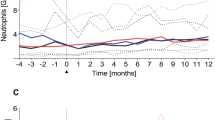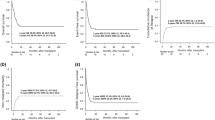Abstract
Allogeneic hematopoietic SCT (HSCT) is increasingly considered an option in refractory or relapsing lymphoma. Today, most patients with B-cell lymphoma are treated with the monoclonal anti-CD20 antibody rituximab before HSCT. We hypothesized that prior therapy with rituximab might alter immune reconstitution after allogeneic transplantation due to in vivo depletion of B cells at the time of graft infusion. We studied B-cell immune reconstitution in 12 patients with lymphoma receiving rituximab 1–12 months before HSCT. Compared to an age- and sex-matched population of patients transplanted for myeloid malignancies, lymphoma patients with rituximab pretreatment showed significantly reduced B-cell counts at time of HSCT at +3, +6 and +12 months; B-cell counts reached values comparable to controls only 24 months after HSCT. In parallel, levels of immunoglobulins were markedly reduced for up to 2 years post transplant in patients with prior rituximab treatment. Two patients suffered from severe late bacterial infections to which the impaired humoral immunity may have contributed. In contrast, T- and NK-cell reconstitution was not different compared to control patients.In conclusion, B-cell reconstitution can be significantly delayed in allogeneic HSCT recipients with prior rituximab treatment. Rituximab appears to have clinical consequences beyond the immediate early post-transplant period.
This is a preview of subscription content, access via your institution
Access options
Subscribe to this journal
Receive 12 print issues and online access
$259.00 per year
only $21.58 per issue
Buy this article
- Purchase on Springer Link
- Instant access to full article PDF
Prices may be subject to local taxes which are calculated during checkout


Similar content being viewed by others
References
Corradini P, Dodero A, Farina L, Fanin R, Patriarca F, Miceli R et al. Allogeneic stem cell transplantation following reduced-intensity conditioning can induce durable clinical and molecular remissions in relapsed lymphomas: pre-transplant disease status and histotype heavily influence outcome. Leukemia 2007; 21: 2316–2323.
Khouri IF . Reduced-intensity regimens in allogeneic stem-cell transplantation for non-hodgkin lymphoma and chronic lymphocytic leukemia. Hematology Am Soc Hematol Educ Program 2006, 390–397.
Schmitz N, Dreger P, Glass B, Sureda A . Allogeneic transplantation in lymphoma: current status. Haematologica 2007; 92: 1533–1548.
Sorror ML, Storer BE, Maloney DG, Sandmaier BM, Martin PJ, Storb R . Outcomes after allogeneic hematopoietic cell transplantation with nonmyeloablative or myeloablative conditioning regimens for treatment of lymphoma and chronic lymphocytic leukemia. Blood 2008; 111: 446–452.
Coiffier B, Lepage E, Briere J, Herbrecht R, Tilly H, Bouabdallah R et al. CHOP chemotherapy plus rituximab compared with CHOP alone in elderly patients with diffuse large-B-cell lymphoma. N Engl J Med 2002; 346: 235–242.
Coiffier B . Rituximab therapy in malignant lymphoma. Oncogene 2007; 26: 3603–3613.
Plosker GL, Figgitt DP . Rituximab: a review of its use in non-Hodgkin's lymphoma and chronic lymphocytic leukaemia. Drugs 2003; 63: 803–843.
Buser AS, Stern M, Bucher C, Arber C, Heim D, Halter J et al. High-dose chemotherapy using BEAM without autologous rescue followed by reduced-intensity conditioning allogeneic stem-cell transplantation for refractory or relapsing lymphomas: a comparison of delayed versus immediate transplantation. Bone Marrow Transplant 2007; 39: 335–340.
Arber C, Buser A, Heim D, Weisser M, Tyndall A, Tichelli A et al. Septic polyarthritis with Ureaplasma urealyticum in a patient with prolonged agammaglobulinemia and B-cell aplasia after allogeneic HSCT and rituximab pretreatment. Bone Marrow Transplant 2007; 40: 597–598.
Maloney DG, Grillo-Lopez AJ, White CA, Bodkin D, Schilder RJ, Neidhart JA et al. IDEC-C2B8 (Rituximab) anti-CD20 monoclonal antibody therapy in patients with relapsed low-grade non-Hodgkin's lymphoma. Blood 1997; 90: 2188–2195.
Kimby E . Tolerability and safety of rituximab (MabThera). Cancer Treat Rev 2005; 31: 456–473.
Nitta E, Izutsu K, Sato T, Ota Y, Takeuchi K, Kamijo A et al. A high incidence of late-onset neutropenia following rituximab-containing chemotherapy as a primary treatment of CD20-positive B-cell lymphoma: a single-institution study. Ann Oncol 2007; 18: 364–369.
Author information
Authors and Affiliations
Corresponding author
Rights and permissions
About this article
Cite this article
Buser, A., Stern, M., Arber, C. et al. Impaired B-cell reconstitution in lymphoma patients undergoing allogeneic HSCT: an effect of pretreatment with rituximab?. Bone Marrow Transplant 42, 483–487 (2008). https://doi.org/10.1038/bmt.2008.229
Received:
Revised:
Accepted:
Published:
Issue Date:
DOI: https://doi.org/10.1038/bmt.2008.229
Keywords
This article is cited by
-
T cell regeneration after immunological injury
Nature Reviews Immunology (2021)
-
Successful treatment with rituximab of an infant with refractory autoimmune hemolytic anemia
International Journal of Hematology (2013)
-
Natural killer cells and malignant haemopathies: a model for the interaction of cancer with innate immunity
Cancer Immunology, Immunotherapy (2011)



